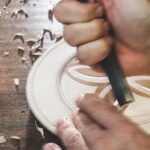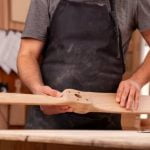Woodworking requires precision and attention to detail, particularly when it comes to ensuring that every piece is square. Squareness refers to the perfect 90-degree angle between two adjacent sides of a woodworking project. It is crucial because any discrepancies can lead to misaligned joints, uneven surfaces, and poor overall craftsmanship.
Without proper squareness, a project may not fit together correctly or have structural integrity. Checking for squareness is a fundamental aspect of woodworking that should never be overlooked. Fortunately, there are various methods and tools available to ensure precise squareness in your work.
In this article, we will explain the concept of squareness in woodworking and why it is essential. We will also explore the necessary tools you’ll need for checking squareness as well as provide a step-by-step guide on how to perform these checks accurately.
Additionally, we will address common issues that arise when trying to achieve perfect squareness, offer solutions for correcting inaccuracies, and share advanced techniques for those looking to take their woodworking skills to the next level.
Whether you are a beginner woodworker or an experienced craftsman, mastering the art of checking for square in woodworking is key to producing high-quality pieces. By following our expert tips and guidelines, you can ensure that your projects are precise, durable, and visually appealing. Let’s dive into the world of checking for square in woodworking and discover how this essential skill can elevate your craftsmanship to new heights.
Understanding the Concept of Squareness in Woodworking
In woodworking, squareness refers to the measurement of how closely a corner or edge forms a 90-degree angle. This concept is crucial in ensuring that pieces fit together properly and that finished projects are structurally sound. Understanding the concept of squareness is essential for any woodworker looking to achieve precise and accurate results.
One way to visualize squareness is by imagining a right triangle, where one side represents the horizontal edge of a piece, another side represents the vertical edge, and the hypotenuse represents the diagonal connecting those two edges. In a perfectly square piece, the horizontal and vertical edges would meet at a perfect 90-degree angle, making the hypotenuse equal in length to both sides.
To assess squareness, carpenters rely on various tools that allow them to measure and compare angles. Some common tools used include:
- Combination Square: This versatile tool consists of a ruler with an adjustable arm that can be set at different angles to check for squareness. It can also be used for measuring and marking straight lines.
- Framing Square: Also known as a carpenter’s square, this L-shaped tool has long legs that can be placed against two edges to determine if they form a right angle.
- Speed Square: A more compact version of the framing square, this triangular tool is often used by carpenters when marking or cutting rafters and stair stringers.
- Bevel Gauge: This tool allows woodworkers to measure and transfer angles from one piece to another accurately.
By understanding these basic principles of squareness and having these essential tools at hand, woodworkers can effectively assess accuracy in their projects. In the next section, we will provide step-by-step instructions on how to use these tools to check for squareness in your woodworking projects.
Essential Tools for Checking Squareness in Woodworking
To ensure accuracy and precision in woodworking, it is crucial to have the right tools for checking squareness. These tools help you determine if your project is perfectly square or if adjustments are needed. Here are some essential tools that every woodworker should have:
- Combination Square: A combination square is a versatile tool that has a ruler, a 90-degree angle blade, and a 45-degree angle blade. It can be used to measure and mark precise angles, as well as check for squareness in woodworking. By aligning the 90-degree blade with an edge of your workpiece, you can easily determine if it is perfectly perpendicular.
- Framing Square: Also known as a carpenter’s square, a framing square is another valuable tool for checking squareness. It consists of two arms that form a right angle and are used to check the corners of large projects such as cabinets or tables. By placing the arms against the edges of your workpiece, you can quickly identify any discrepancies in squareness.
- Try Square: A try square is a smaller version of a framing square and is ideal for checking small-scale projects or tight corners. It typically has a wooden handle and a metal blade with markings for accurate measurements. By holding it against the edges or corners of your workpiece, you can easily determine if they are perfectly at right angles.
- Set Squares: Set squares, also known as triangle squares or precision triangles, come in various sizes and angles to suit different needs. They are primarily used for marking and measuring angles accurately but can also be utilized to check for squareness.
These essential tools will help you in accurately checking whether your woodworking project is perfectly square or not. Investing in quality tools will save you time and effort in the long run by ensuring precise results from the start.
| Tool | Description |
|---|---|
| Combination Square | A versatile tool with a ruler, 90-degree angle blade, and 45-degree angle blade. Used for measuring angles and checking squareness in woodworking. |
| Framing Square | A carpenter’s square consisting of two arms forming a right angle. Ideal for checking the corners of large projects. |
| Try Square | A smaller version of a framing square with a wooden handle and metal blade. Used to check small-scale projects or tight corners. |
| Set Squares | Triangle-shaped tools available in various sizes and angles. Primarily used for marking and measuring angles accurately, but can also check squareness. |
Step-by-Step Guide
Checking for squareness is an essential step in woodworking to ensure accurate and precise measurements. Whether you are building furniture or framing a structure, having square corners is crucial to the overall stability and functionality of the project. In this step-by-step guide, we will walk you through the process of checking for squareness in woodworking.
- Start by selecting a reliable square tool: A square is a measuring tool with a straight edge and perpendicular sides that is used to determine if corners or edges are perfectly 90 degrees. Choose a high-quality square that is made from durable materials like steel or aluminum, ensuring its accuracy and longevity.
- Prepare your workpiece: Before beginning the measurement, make sure your workpiece is clean and free from any debris that could affect the accuracy of your readings. It’s also important to check that the edges you’ll be measuring are straight and flat.
- Position your square: Place one side of the square against one edge of the workpiece, ensuring it makes full contact along its entire length. The other side of the square should be aligned with another edge forming a perfect 90-degree angle.
- Check for squareness: Once positioned, observe the gap between the edge of your workpiece and the edge of the square. If there is no gap, then your corner is perfectly square. However, if there is a gap on one side, it means that your corner is not at a right angle.
- Diagonal measurement method: Another way to check for squareness is by using diagonal measurements. Measure the distance between two opposite corners diagonally going from one corner to another (e.g., top left to bottom right). Then measure diagonally from the remaining corners (e.g., top right to bottom left). If both diagonal measurements are equal, then your corner is perfectly square.
- Adjusting for inaccuracies: If you find that your workpiece is not perfectly squared, you will need to make adjustments. This can be done by trimming or sanding the edges that are not square. You can also use clamps or braces to hold your workpiece in the correct position while making adjustments.
Checking for squareness is an essential skill in woodworking that can make a significant difference in the overall quality of your projects. By following this step-by-step guide and using the right tools, you’ll be able to ensure precise measurements and achieve perfectly square corners in your woodworking endeavors.
Common Issues and Challenges in Ensuring Squareness
Ensuring squareness in woodworking can sometimes present challenges and common issues that woodworkers often encounter. Understanding these challenges and knowing how to address them is crucial in achieving accurate squareness in your woodworking projects.
Material Warping
One of the common challenges in ensuring squareness is material warping. Wood has a natural tendency to change shape, especially when exposed to different humidity levels. This can result in boards that are no longer perfectly flat or square, making it difficult to achieve accurate measurements.
To overcome this challenge, it is important to start with properly dried and acclimated wood. Avoid using green or wet wood, as it is more prone to warping. Additionally, storing your wood in a climate-controlled environment can minimize the effects of humidity changes.
If you encounter warped boards during your project, there are several techniques you can use to correct the issue. One method is by applying pressure to the opposite side of the warp using clamps or weights and allowing it to sit for a period of time. Another option is to use a jointer or hand plane to remove material from the high points of the warp until the board becomes flat and square again.
Inaccurate Measurements
Another challenge in ensuring squareness is obtaining accurate measurements. Even small inaccuracies can compound over larger distances, resulting in projects that are noticeably out of square.
To ensure accurate measurements, always use reliable measuring tools such as a quality combination square or a precision measuring tape that has been calibrated. Check for any damage or wear on your measuring tools regularly, as this can affect their accuracy.
In addition to using quality tools, it is essential to have proper technique when taking measurements. Take your time and double-check each measurement taken during your woodworking project. If possible, have another person verify your measurements for added reliability.
Joint Alignment
Aligning and joining pieces of wood is another challenge in ensuring squareness. If the joints between boards are not perfectly aligned, it can throw off the overall squareness of your project.
To address this challenge, take extra care during the gluing and clamping process. Use appropriate clamps to apply even pressure across the joint, ensuring a tight fit. Take note of any gaps or misalignments during dry-fitting, and make necessary adjustments before applying glue.
If you find that the joint is not perfectly square after gluing, you can still make corrections. Carefully plane or sand the joint until it becomes flat and square. However, it is best to avoid such issues by ensuring proper alignment and fit before gluing.
By being aware of these common issues and challenges in ensuring squareness, you can implement strategies to overcome them and achieve accurate results in your woodworking projects. Taking steps to minimize material warping, obtaining accurate measurements, and addressing joint alignment will significantly contribute to achieving precise squareness in your workmanship.
How to Adjust and Correct Inaccuracies in Squareness
Identifying Inaccuracies in Squareness
Before you can begin the process of adjusting and correcting inaccuracies in squareness, it is crucial to identify where these inaccuracies lie. The most common method for identifying squareness issues is by utilizing a precision measuring tool such as a square.
Place the square against the edges or corners that you suspect may be out of square and observe any gaps or misalignments. Additionally, using a straight edge can help detect any variations in flatness, which can also contribute to squareness problems.
Adjustment Techniques for Squareness Issues
Once you have pinpointed the areas that require adjustment, there are several techniques you can employ to correct inaccuracies in squareness.
One commonly used method is known as “tapping.” This involves using light hammer taps to nudge the piece into alignment. Begin by tapping on the side that needs adjustment while keeping constant pressure against a reference surface to ensure accurate alignment. Continue tapping until the piece is properly squared.
Another technique is called “shimming.” Shims, which are thin pieces of material such as cardboard or metal, can be inserted between two surfaces to compensate for any gaps or misalignments. By strategically placing shims in specific areas, you can bring the piece back into square.
If the inaccuracies are more severe or persistent, it may be necessary to make adjustments to your tools and equipment. For example, if your table saw blade is not perfectly perpendicular to your table, it can lead to inaccurate cuts and affected squareness. In this case, consult your tool’s manual for instructions on how to adjust and calibrate it correctly.
Maintaining Squareness
After making adjustments and achieving proper squareness, it is important to maintain this accuracy throughout your woodworking project. Regularly check for any shifts or deviations during each stage of construction. Avoid placing excessive pressure or force on components that can cause them to shift out of square. Additionally, store your tools properly to prevent any misalignments or damage that may affect their accuracy.
By consistently checking for and correcting inaccuracies in squareness and following these maintenance practices, you will enhance the quality and precision of your woodworking projects. Remember, achieving perfect squareness is a continuous learning process that requires patience and practice, but the results are well worth the effort.
Pro Tips for Achieving Perfect Squareness in Woodworking
Woodworking requires precision and attention to detail, especially when it comes to achieving perfect squareness. Here are some pro tips to help you achieve the desired level of accuracy in your woodworking projects:
- Use a reliable square: Invest in a high-quality and precise square that will serve as your main tool for checking squareness. A combination square or a try square are popular choices among woodworkers. Ensure that the edges of the square are straight and true, and regularly check its accuracy using a known reference.
- Check multiple ways: To ensure accurate squareness, always double-check your measurements using different methods. For example, you can use the 3-4-5 triangle method, where you measure three units on one line, four units on another line perpendicular to it, and if the diagonal measures five units, then it is perfectly squared.
- Pay attention to clamping: When assembling pieces together, make sure they are securely clamped before checking for squareness. Clamping ensures that the pieces maintain their position during measurement and prevents any movement that could affect accuracy.
- Practice proper technique: When measuring for squareness, hold your tools firmly against the workpiece without applying excessive pressure. Avoid any tilting or rocking motion that could throw off your measurements. Take precise readings at different points along the edges to identify any variations.
| Pro Tip | Description |
|---|---|
| Use a reliable square | Invest in a high-quality and precise square for accurate measurements. |
| Check multiple ways | Double-check measurements using different methods like the 3-4-5 triangle method. |
| Pay attention to clamping | Ensure pieces are securely clamped to prevent any movement during measurement. |
| Practice proper technique | Hold tools firmly, avoid tilting or rocking, and take precise readings at multiple points. |
By following these pro tips, you can significantly improve your ability to achieve perfect squareness in woodworking. Remember that practice makes perfect, so take the time to develop your skills and always strive for accuracy in your projects. Mastering the art of checking squareness will help ensure that your woodworking creations are structurally sound and visually appealing.
Advanced Techniques for Checking Squareness in Woodworking
While the basic techniques for checking squareness in woodworking are essential, there are also more advanced methods that can provide even greater precision and accuracy in your work. These techniques are particularly useful when working on intricate or complex projects where precise measurements and angles are crucial. Here are a few advanced techniques that can help you achieve perfect squareness in your woodworking:
- Diagonal Measurement Method: This technique involves taking diagonal measurements across a square or rectangular object to determine if it is perfectly square. To do this, measure the distance between opposite corners of the object using a tape measure. If the two diagonal measurements are equal, then the object is square. If they differ, it means that the object is not perfectly square and adjustments will need to be made.
- 3-4-5 Method: The 3-4-5 method is a popular technique used to ensure squareness when building larger structures such as walls or frames. It relies on the principle that a triangle with sides measuring 3 units, 4 units, and 5 units will always form a right angle at the corner opposite the side measuring 5 units.
To use this method, simply measure out 3 units along one edge of your project, then 4 units along another edge that meets the first edge at a right angle. Finally, measure the distance between these two points – if it measures exactly 5 units, then your project is perfectly square. - Parallel Clamping Method: This technique involves clamping two parallel boards at opposite corners of your project to create a diagonal reference line. By measuring from this line to various points on your project and comparing those measurements across different sections, you can determine if your project is square or not. This method is particularly useful for large or irregularly shaped objects where traditional square-checking methods may not be practical.
These advanced techniques may require some additional tools or measurements, but they can provide a higher level of accuracy and precision when checking for squareness in woodworking. By incorporating these methods into your practice, you can ensure that your projects are always perfectly square and achieve the highest quality results.
Remember, mastering the art of checking squareness in woodworking takes practice and patience. It’s important to understand the basic concepts and techniques before moving on to more advanced methods. With time and experience, you’ll become more proficient in ensuring squareness and produce professional-level woodworking projects.
Frequently Asked Questions (FAQs) about Checking for Squareness in Woodworking
Woodworking is a craft that requires precision and attention to detail. One crucial aspect of woodworking is ensuring that the pieces being worked on are perfectly square. However, checking for squareness can be confusing for beginners and even experienced woodworkers at times. In this section, we will address some frequently asked questions about checking for squareness in woodworking.
- Q: What does it mean for a piece of wood to be square in woodworking?
- A: In woodworking, a piece of wood is considered square when all angles are exactly 90 degrees and all sides are parallel or at right angles to each other. This ensures that the project being built will fit together accurately, making it sturdy and visually appealing.
- Q: Why is checking for squareness important in woodworking?
- A: Checking for squareness is crucial in woodworking because any inaccuracies can result in ill-fitting joints, warped assemblies, and unstable structures. A lack of squareness can compromise the overall quality and functionality of the final piece. By ensuring everything is perfectly square, woodworkers can achieve precise results and create projects that are both aesthetically pleasing and structurally sound.
- Q: What are some common tools used to check for squareness in woodworking?
- A: There are several essential tools that woodworkers use to check for squareness. The most common ones include a combination square, framing squares, try squares, carpenter’s squares, precision measuring tools like calipers or micrometers, and even digital angle finders. These tools help ensure accuracy when measuring angles and checking for perpendicularity between different surfaces.
By addressing these commonly asked questions about checking for squareness in woodworking, beginners can gain a better understanding of the concept and importance behind this critical aspect of the craft. With proper knowledge and the right tools at hand, woodworkers can confidently tackle their projects knowing they have achieved perfect accuracy and squareness.
Conclusion
In conclusion, checking for squareness in woodworking is an essential skill that every woodworker should master. It ensures the accuracy and precision of your projects, allowing for a seamless fit and beautiful end result. By understanding the concept of squareness and using the right tools, you can easily check for squareness during your woodworking process.
The step-by-step guide provided in this article offers a simple and effective method to check for squareness. Following these steps will help you identify any inaccuracies and make necessary adjustments to ensure your project is perfectly squared. Additionally, the common issues and challenges discussed in this article provide valuable insights on how to overcome potential problems that may arise.
To achieve perfect squareness in your woodworking, it is important to follow some pro tips. These tips include using reliable measuring tools, checking squareness at multiple points along your project, and applying consistent pressure when making adjustments. These techniques will greatly improve the accuracy of your measurements and minimize errors.
For more advanced woodworkers, there are additional techniques available to enhance the accuracy of checking squareness. These techniques include using precision squares with adjustable blades, employing digital angle finders for precise measurements, and incorporating advanced software or apps specifically designed for woodworking projects.
By mastering the art of checking square woodworking, you will elevate the quality of your workmanship and create impressive projects that stand out. With patience, practice, and attention to detail, you can become proficient in ensuring squareness in all your future woodworking endeavors. Remember to continuously educate yourself on new techniques and stay updated with advancements in tools and technology to improve your craftsmanship even further.

Hi everyone! I’m a woodworker and blogger, and this is my woodworking blog. In my blog, I share tips and tricks for woodworkers of all skill levels, as well as project ideas that you can try yourself.





